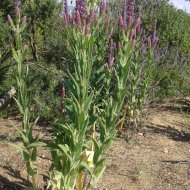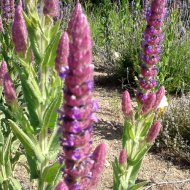Care of the plant Nepeta tuberosa or Catmint |
|
The genus Nepeta, family Lamiaceae, comprises about 250 species of herbaceous plants native to Europe, Asia, and Africa. Some species and hybrids are: Nepeta tuberosa, Nepeta cataria, Nepeta × faassenii, Nepeta grandiflora, Nepeta teydea, Nepeta curviflora, Nepeta nepetella. Common name: Catmint. This species is native to the Iberian Peninsula, Europe. They are perennial herbaceous plants with tuberous roots and branching from the base that reach 90 cm (35.43") in height when flowering. The opposite leaves are lanceolate in shape and velvety in texture. The showy, long flower spikes bear small blue, purple, or white flowers. They bloom in spring and summer. Catmint is used in rockeries, borders and borders, as isolated specimens, on dry and sunny slopes and in Mediterranean gardens. It combines very well with plants of the genera Stachys, Artemisia and Calamagrostis. It has medicinal properties. Nepeta tuberosa needs full sun exposure and a warm, dry climate. Withstands occasional and light frosts if the soil is dry. Catmint can grow on calcareous, stony, clayey and sandy soils, as long as they have good drainage. Nepeta tuberosa is a drought resistant plant that needs moderate watering waiting for the substrate to be completely dry. It is not necessary to fertilize. Prune withered inflorescences to encourage the appearance of new flowers and to maintain a compact habit. Catmint is a plant resistant to the usual pests and diseases but sensitive to excess humidity. Nepeta tuberosa is propagated from seeds sown in the fall, by division in the spring, and by cuttings in the summer. |
Images of the plant Nepeta tuberosa or Catmint |
Find plants
Nepeta tuberosa or Catmint | Care and Growing
© 2026 FavThemes

